Two days ago, we woke up at 4AM to pack up camp and move out of Tamarack Flats. Our goal was to be the first ones on Washington Column, our first Grade V big wall (Grade V means that most parties require a night sleeping on the wall to complete the route). The route is a very popular choice for first time wallers, and though we were not entirely new to the big wall game, we didn’t want to take any chances by starting late and falling behind other parties. Our ploy worked, sort of. We were at the base of the wall by 7:30AM, with one party already on the wall (two ladies looking to complete an in-a-day ascent) and one arriving right behind us only five minutes later. Our goal for the first day was to climb to Dinner Ledge, an enormous ledge that sleeps “six” (though we heard rumors of sixteen squeezing in with enough creativity), and fix line one and a half pitches higher to get a head start for the next day.

Matt took the day’s first block, with two 5.7 free climbing pitches sandwiched around an easier aid pitch. Though he smoked his free pitches with excellent speed, we got passed on the aid pitch by the party behind us, who chose to climb a 5.10a free variation around us. This was fine with us, as this party seemed rather experienced and we were as of yet unsure of our speed relative to more experienced (and smaller) parties. Matt finished his block in great style, putting us on Dinner Ledge by 11:20AM. It was surreal to get to our endpoint well before noon, and we head nine hours of daylight left to enjoy each other’s company in a small, 50 square foot ledge 300 feet off of the ground. The views of Half Dome were tremendous, and Elam and I spent much of the day FaceTiming loved ones and showing off our new home.
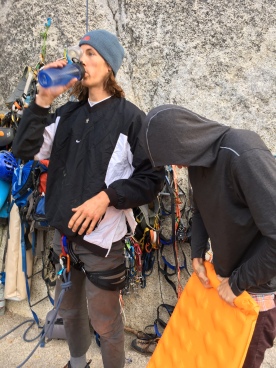
Voss and Matt, however, still had some work to do. The pitch-and-a-half above Dinner Ledge is the aid crux of the entire route, meandering up an intimidating feature called the Kor Roof. Layton Kor, the leader of the first ascent team of the South Face route, is one of those names in climbing that demands respect–nay, reverence–as his bold and fearless ascents in Colorado and Moab consistently beg the question “who would think this line was possible?” The Kor Roof pitch is that signature section for the South Face: an intimidating, horizontal roof with a crack emerging just over the lip. There are several memorable sections of the pitch, but the “inside joke” of it all is that Layton Kor stood a whopping 6’4″ and loved placing protection from the very top step of his aid ladder. If this doesn’t make sense to you, the basic gist is that the man could reach really far, which is a prime-time physical trait in the aid climbing world.
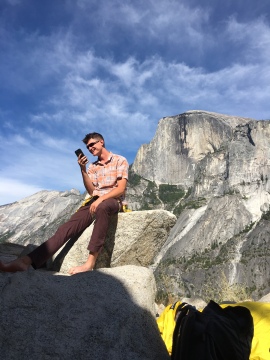
Lucky for us, we had a Layton Kor of our own in Andrew Voss, himself a 6’5″ human being. Unlike Layton Kor, however, Voss has been climbing for nine months and is an OK climber with only one first ascent to his name. Nonetheless, Voss loves aid climbing, a sequence of words hardly ever heard in the English language. Elam and I spent the next hour and a half sitting on our sleeping pads, staring up at our tall friend wildly screaming with joy as he clipped his way up piece after piece of protection, crawling ever-so-slowly up the pitch behind a train of other parties.

Among these other parties, and there were many, were the “in-a-day” ladies up front, the guys who passed us up next, and a team of two Danes with awesome accents. All were very friendly, and some of them expressed considerable surprise at our being a team of four. Perhaps even more surprising was that we were a team of four that wasn’t traveling at a snail’s pace. At least, it didn’t seem that we were moving slow, since a large queue of parties were clustered above on the Kor Roof pitch, waiting for the next party to get off the previous belay. After hours of waiting, Voss made it to the pitch’s most exciting section: a short pendulum to the left. A pendulum demands that the climber lower down a few feet off of a piece of protection and swing back and forth, eventually lunging to the side to reach a far-away crack. He tried this twice, each time failing to grab the crack. “I’m just going to pull on the other team’s ropes!” shouted Voss. Mockery erupted from Dinner ledge, as the experienced team shouted “C’mon dude, just do it!” Voss began running back and forth a third time, 500 feet of air below him. He lunged left, and–stuck it! A loud shout of joy erupted from the Voss. We cheered. A few minutes later, Voss and Matt lowered down to Dinner Ledge, where we ate dinner and watch the beautiful sunset on Half Dome.
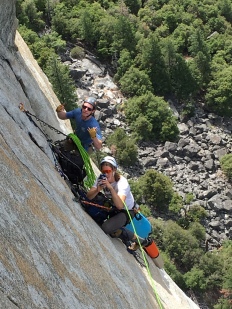
The next day, Elam and I blasted off on the fixed lines. Elam’s block was first, with two and half long aid pitches. The description in the topo (route map) described this section briefly: “many nuts.” Basically, the entire pitch was led by Elam hanging on tiny chocks made of aluminum and brass. He took a fall, but emerged relatively unscathed. By the end of the block, Elam was stoked with his increased trust in small pieces of protection.
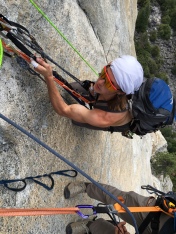
I took the lead for the final block, a mixed bag of free climbing and aid sections. My first pitch was a breeze, but the second was a mostly-free squeeze chimney pitch. For those who read my trip report on “Braille Book,” the most strenuous size of crack to climb is offwidth, situated between 4 and 7 inches, such that you can’t fit your body inside. The second most strenuous crack size, however, is squeeze chimney. A squeeze chimney is a crack that you can fit in, but only barely. Then, you have to grunt your way higher, inch by inch, until you feel like you are going to pass out. I didn’t realize the difficulty of this “5.8” pitch until I realized that I was many feet above my protection with no options but to jam my entire body into a crack a few millimeters too narrow to feel secure. Once half inside, I pushed myself up as hard as I could. I didn’t budge. I tried again. I didn’t budge. I shifted my feet, clenched my teeth and pushed as hard as possible. My vision blurred as I reached into the crack for the hold ahead. I felt like I was going to die, and my strength gave out and I fell. Except I didn’t fall, I just stayed in the same place (the great thing about squeeze chimneys is that, as insecure as you feel, you’re still tightly wedged into a crack and can’t really fall). After I calmed down a bit, I worked my way slowly past this section and swore off squeeze chimneys from now on, or at least until the memory of the experience fades.
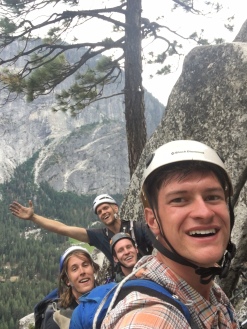
The last pitch was easy, and took us to a point just 100 feet shy of the summit. We decided to skip the last pitch, a loose-rock-filled sandy gully known for raining projectiles down upon innocent victims on Dinner Ledge. We estimated that dragging four guys and a haul bag up this pitch would kill no less than ten people, so we stopped just short of the top. This is a common strategy, and our ascent still counts, so don’t worry. We took a photo at the top, drank some water and began three long hours of rappelling to the base. We got off the rock before dark, and spent the evening cooking freeze-dried meals on a crash pad in the parking lot as passers-by observed with incredulity. We did a great job on Washington Column, made good time and didn’t feel too wiped. Hopefully, we’ll be able to say the say about the harder objectives ahead.


Be smart and be safe guys and don’t challenge yourselves to the point of near exhaustion! God speed be with you!
LikeLiked by 1 person
Wow. You guys weren’t kidding when you said you had a blog. So awesome.
LikeLike